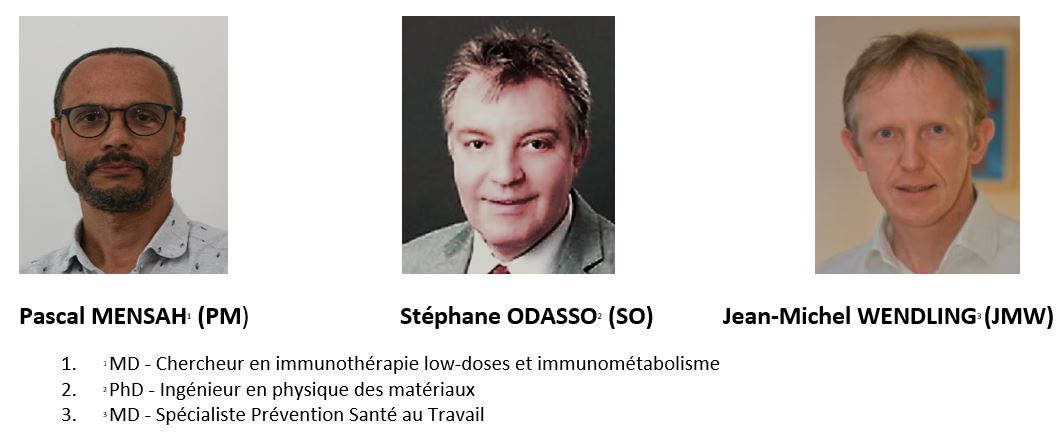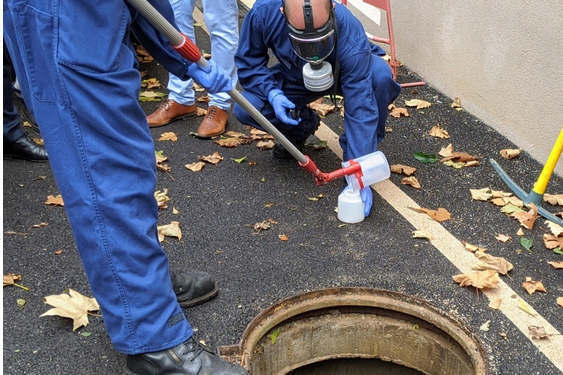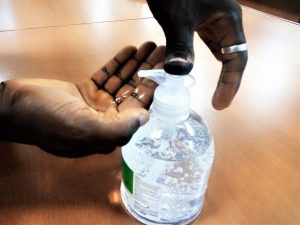Pascal Mensah, Stéphane Odasso and Jean-Michel Wendling* state that the risk of “aerosol” contamination is unlikely. The source of contamination is elsewhere. It is twofold: dirty hands towards the mouth or eyes and big sputters towards the glass and the plate. Explanations and cross-maintenance.

With factual evidence from very recent studies, all three of you consider that aerosol risk is the exception, can you explain how you came to this conclusion?
Stéphane Odasso: Indeed! It should be remembered here that aerosols are those particles less than 5 microns in size that remain suspended in the air for several hours, a bit like the dust we see in a room lit by the beam of a sunbeam. A very recent scientific study by Asadi et al. shows that the production of these particles increases with speech, its intensity, singing, and finally coughing. The size of these particles is mostly around 0.75 micron (1). However, we know the viral load in one milliliter of saliva: it has been evaluated on average between 9.92 x 104 and 3.3 x 106 copies/ml (2) (3).
Aerosol: an unlikely mode of transmission
 With a small mathematical calculation (volume/diameter of a sphere) of terminal level that each one will be able to remake, one arrives at estimating for the high average, the viral load in a particle of 0.75 micron of diameter. And there, surprise!
With a small mathematical calculation (volume/diameter of a sphere) of terminal level that each one will be able to remake, one arrives at estimating for the high average, the viral load in a particle of 0.75 micron of diameter. And there, surprise!
If in a “big” droplet of 100 microns (easily stopped by a mask) we have 1.7 copies of RNA, the microparticles of 0.75 µ (aerosols therefore) would contain 7.29 x 10-7 copies. Theoretically, one would then have to continuously inhale 1. 370.000 particles to have a chance to encounter the first “virus”. Mathematical projections based on experimental results are therefore against a major dispersion by the aerosols usually evacuated by speech. Think that for breathing only, we are still on emissions by 8 times less!
Do we have scientific studies that allow us to be reassured about this hypothesis of aerosol transmission?
Jean-Michel Wendling: A beautiful Swedish study published at the end of September is very much in this direction: on 2 symptomatic singers who were symptomatic and highly positive in RT-PCR (CT 22 and 25) and who sang in a tunnel from which the air was sampled and analyzed, no viral particles were collected (4).
Pascal Mensah: And then, if we look at the results of the microbiological investigations on the Diamond Princess (5) or the readings of COMETE, the specialized COVID19 and biological risk unit of the Marseille Firefighters Battalion (BMPM), none of the investigators found any virus in the air samples. These situations of aerosol transmission, if they are possible and published, therefore seem exceptional.
If aerosols were the main mode of transmission, one could be concerned about closed spaces such as airplanes: what is the real situation?
JMW: Aircraft have efficient ventilation systems with HEPA filtration in flight. Even so, passengers spend a good hour on the ground waiting with the promiscuity we know when boarding or disembarking. At this date, to our knowledge, only 44 reported cases of COVID-19 have been attributed to air travel since the beginning of 2020 out of approximately 1.2 billion passengers who traveled during this period. A study by the International Air Transport Association (IATA) on the frequency of contamination in aircraft (confined spaces) also concludes that the risk is extremely unlikely according to the terms used by the authors of the report, and this after 300 tests carried out by releasing 180,000,000 particles of the fluorescent tracer from the aerosol source (simulated virus aerosols), with 11,500 measurements located on seats in the respiratory area throughout the cabin (6).
Masks or any barrier device against spittle are useful
A barrier device is therefore necessary according to you. What do you think about masks and their usefulness against aerosols and VIDOC-19?
JMW: The various experiments and tests by notified bodies show that masks (surgical or woven) are not impermeable to particles smaller than 1 micron, and in addition that they also leak massively upwards and sideways, especially if they are poorly fitted on the face. You can see this by testing your mask with electronic cigarette smoke or by seeing the mist forming on your glasses with each exhalation. Asadi S.’s work team even showed that a fabric mask emitted more particles than without a mask: surprisingly, wearing a cotton mask based on a single-layer unwashed T-shirt resulted (only when breathing) in a significant 384% increase in the number of particles emitted compared to the median value without a mask (1). It is rather embarrassing…If they are effective, it is according to us, thanks to their barrier effect against sputtering; on the other hand, they are not impermeable to aerosols…Moreover, wearing them is not relevant outdoors, if the distance of one meter can be respected in France.
Disinfection and hygiene
PM: In addition, if aerosols were heavily involved, and given the technical limitations of masks, the epidemic would not have been controlled by the widespread use of masks in Asian countries such as Singapore or Hong Kong. The culture of prevention, disinfection, and hygiene is also very different from ours, with hand washing being much better followed, in our opinion. It is a whole! A meta-analysis even shows that wearing a mask, despite its limitations, is associated with a 96% reduction in the risk of contamination for Sars/CoV-2, whereas for influenza, the result is limited to 45%, which suggests that influenza is much more associated with this “aerosol” mode of transmission, which is more difficult to control than Sars/CoV-2 (7).
From our mouth to the plate and the glass: a culprit spits it out?

SO : The risk linked to the projection of a spit is quite different: a single spit of one millimetre that sometimes comes out of our mouth when we speak is, theoretically according to our calculations, at least 1730 viral particles projected into a glass or a plate if the cook is not equipped with a physical barrier such as a mask, which is for this reason, indispensable!
PM: In addition, an enlightening element, the investigations on the Princess Diamond show that out of 20 people in the sick crew, 14 worked in the catering trade and 2 in the “drinks” service… The mask or any other barrier device is therefore indispensable to retain the large droplets or sputters that potentially have high viral loads, particularly for professionals who prepare meals.
Fecal risk and dirty hands
PM: Sars CoV-2 is present in the faeces: this notion is not well enough known and, consequently, in the toilets, where viral concentrations can reach 108/gr, i.e. on average 100 times more than in saliva (150gr of faeces per day); on the other hand, the virus was found alive in 2 scientific studies: viral RNA was detected in the faeces in 81.8% of cases (8). It is, in wastewater, a marker of early monitoring and predictive of epidemic dynamics. Follow-up can be carried out on a regular basis in wastewater treatment plants in large cities. Moreover, 80 EPAHDs in Marseille are monitored weekly, which makes it possible to alert to contamination in a facility and take action as soon as possible (see article on the COMETE unit).
Do you think the virus circulates from toilets to other surfaces?
JMW : It’s very likely. The Princess Diamond surface analysis study (5) showed that the SARS-CoV-2 RNA was detected on several surfaces in the cabins, in the bathroom, or most often on the floor around the toilets, but also on the pillows of the beds, up to 17 days after the cabins were released. The SARS-CoV-2 found on pillows could have come from saliva released during coughing, nasal discharge or tears during sleep. RNA detected on the floor around the toilets could come from stool, of course. At the COMETE unit in Marseille, which has carried out more than 8000 samples, the majority of which were surface samples, viral RNA was very often found around toilets and in the wastewater of buildings. The analysis of wastewater is indeed an early collective indicator! Viral particles have also been identified on shared surfaces, elevator controls, cash dispenser keys, handrails, taps, sinks, computer mice, keyboard keys… However, the COMETE unit did not detect any virus with infectious power in the air samples of administrative buildings receiving the public.

How do we explain the fact that in France, the figures are deteriorating while the wearing of the mask seems to be rather well followed?
JMW: Every day we see that hand washing, which was more systematic during confinement, is unfortunately forgotten. On our last evaluations (counting store entrances) which date from yesterday, 89% of customers who entered a large food store in Strasbourg did not disinfect their hands when entering. No guards to watch or incite. No obligation…
We know that the French are not champions of handwashing. A study by Santé Publique France in 2016 (9) showed that about 21% of them (or 14 million by extrapolation) do not wash their hands systematically when leaving the toilet, even though the virus is known to be present in the stools. The latest IFOP survey of October 15 shows that since this summer, barrier gestures have not become natural gestures. The French are thus much less numerous than last spring to systematically wash their hands on their way home (-23 points), before eating (-16 points) or after blowing their nose (-19 points). This drop is particularly visible among young people “who are already very resistant to the application of barrier gestures,” the report points out. We can therefore legitimately worry about the contamination of all shared surfaces such as handrails, bus bars, cart handles, and even possibly food and fruit and vegetable stalls in supermarkets where more than 3,000 people a day can follow one another on average… This is undoubtedly where the hole in the racket lies.
An innate bio-persistence, said, Sars-Cov-2 vs. Influenza

How long does the virus persist on hands and surfaces?
PM: Sars CoV-2 is a coronavirus that has an unprecedented bio-persistence on hands (9 to 11 hours), much longer than the flu virus (1.8 hours). It persists about 5 days on plastics and stainless steel, and up to 28 days in the cold and darkness (10). Regular hand and surface washing is therefore essential! The rapid transfer of dirty hands to surfaces, plates, food, face, eyes, door handles, switches was demonstrated in Japan by an experiment with a fluorescent marker*: at the end of a meal around the same table, all the guests were soiled by the marker. In addition, a mask would be immediately contaminated on its external surface if readjusted with hands soiled by the coronavirus.
A health communication error
In summary, worrying the population about the risk of transmission by “aerosols”, presenting it as the main risk, is from all three of us’ point of view, a health communication error.
We believe that transmission is very different from influenza, and much more simply explicable by its double source: sputum and soiled hands (in the toilet, through saliva or nasal discharge).
Of course, aerosols cannot be totally neglected in the transmission of the coronavirus, however this transmission should be considered in our opinion as exceptional and only occur in circumstances combining one or several factors favorable to a greater circulation of the coronavirus: presence of super-spreaders during relatively festive gatherings, irregular disinfection protocols of the most affected surfaces, poorly ventilated closed places, non-respect of barrier gestures.
We insist on the fact that the mask, or any other anti-postillation screen, is therefore indispensable, especially for those who prepare meals for others.
The risk of contamination of hands after blowing a nose, or when leaving the toilets, or of food and drinks by the projection of sputters** is therefore to be taken into account in the light of the available information.
All in all, it seems to us essential to prioritize and raise awareness among the population :
Hand washing, especially when leaving the toilet,
– to regular mistakes when washing (re-contamination of hands) by closing the tap or touching the toilet handle when leaving the toilet without the hand towel,
– hand disinfection when entering supermarkets and any public building, which should be mandatory,
– the importance of carrying a small bottle of hydroalcoholic gel rather than a mask in an outdoor environment, which is less useful in well-ventilated areas where social distancing is respected,
– not to touch his mask or eyes without first disinfecting his hands,
– to wear a spatter barrier, especially when preparing or serving food.
Dr. Pascal Mensah is a researcher in low-dose immunotherapy, Stéphane Odasso, Doctor in materials physics from the University of Aix-Marseille (European label) and Dr. Jean-Michel Wendling, specialist in occupational health prevention (consultant for The FrenchDailyNews).
Références :
1) Asadi, S., Cappa, C.D., Barreda, S. et al. Efficacy of masks and face coverings in controlling outward aerosol particle emission from expiratory activities. 24 sept 2020 Sci Rep 10, 15665 (2020). https://doi.org/10.1038/s41598-020-72798-7
2) Wang W, Chen S, Liu I, Chen Y, Chen H, Yang C, et al. Detection of SARS-associated Coronavirus in Throat Wash and Saliva in Early Diagnosis. Emerg Infect Dis. 2004;10(7):1213-1219. https://dx.doi.org/10.3201/eid1007.031113
3) To KK, Tsang OT, Yip CC,Consistent Detection of 2019 Novel Coronavirus in Saliva. Clin Infect Dis. 2020 Jul 28;71(15):841-843. doi: 10.1093/cid/ciaa149
4) M. Alsved, A. Matamis, R. Bohlin, M. Richter, P.-E. Bengtsson, C.-J. Fraenkel, P. Medstrand & J. Löndahl (2020) Exhaled respiratory particles during singing and talking, Aerosol Science and Technology, 54:11, 1245-1248, DOI: 10.1080/02786826.2020.1812502
5) Takuya Yamagishi, Descriptive study of COVID-19 outbreak among passengers and crew on Diamond Princess cruise ship, Yokohama Port, Japan, 20 January to 9 February 2020 https://www.ncbi.nlm.nih.gov/pmc/articles/PMC7403638/
6) David Silcott, Sean Kinahan, Joshua Santarpia. Commercial Aircraft Cabin Aerosol Dispersion Tests Submitted To: United States Transportation Command (USTRANSCOM) & Air Mobility Command (AMC) https://www.ustranscom.mil/cmd/docs/TRANSCOM%20Report%20Final.pdf
7) Liang M, Gao L, Cheng C, Zhou Q, Uy JP, Heiner K, Sun C. Efficacy of face mask in preventing respiratory virus transmission: A systematic review and meta-analysis. Travel Med Infect Dis. 2020 Jul-Aug;36:101751. doi: 10.1016/j.tmaid.2020.101751.
8) Masaaki Kitajimaa. SARS-CoV-2 in wastewater: State of the knowledge and research needs. Volume 739, 15 October 2020, 139076. Science of The Total Environment. https://doi.org/10.1016/j.scitotenv.2020.139076)
9) Colette Ménard Pratiques d’hygiène et prévention des infections respiratoires de l’hiver : résultats du Baromètre santé 2016 BEH : Santé publique France, Saint-Maurice, France http://beh.santepubliquefrance.fr/beh/2017/22/2017_22_3.html)
10) Riddell, S., Goldie, S., Hill, A. et al. The effect of temperature on persistence of SARS-CoV-2 on common surfaces. Virol J 17, 145 (2020). https://doi.org/10.1186/s12985-020-01418-7
* Expérience vidéo de la diffusion manuportée après 30mn lors d’un repas commun :https://www.youtube.com/watch?v=WDplwOZlOEU
** Etude de simulation pendant un repas partagé – utilité de l’écran facial pour arrêter les projections https://www.nbcwashington.com/news/national-international/animation-shows-how-coronavirus-spreads-at-dinner-table/2445568/

